| |
|
Sunday, May 18 Community Israel Independence CelebrationWednesday, May 28 JFS~Ellen Saks lecture on mental illness
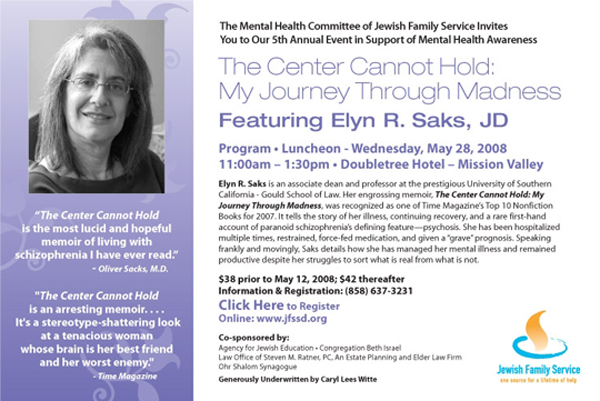
WEDNESDAY, JULY 23-MONDAY, AUGUST 4 Temple Solel trip to Israel


REFLECTIONS
Matzo sandwich: is the Earl laughing?
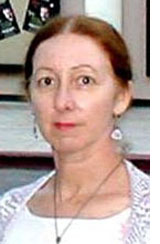 SAN DIEGO-- The neighborhood in Philadelphia in which I spent my childhood was ninety percent Jewish. It was post World War II, and the returning soldiers married and bought homes in this new neighborhood and began raising families. Most of these new home owners were the descendents of immigrant parents, and many of those parents, Bubbas and Zaydas, moved into the new row homes with their married children. SAN DIEGO-- The neighborhood in Philadelphia in which I spent my childhood was ninety percent Jewish. It was post World War II, and the returning soldiers married and bought homes in this new neighborhood and began raising families. Most of these new home owners were the descendents of immigrant parents, and many of those parents, Bubbas and Zaydas, moved into the new row homes with their married children.
Left behind were the older neighborhoods, also row homes, but much smaller, often with streets too narrow for cars to navigate. They had been built during the time of horse and wagon, with gas lit street lamps – part of the mosaic of the ethnic map of Philadelphia. Also left behind were the old synagogues where Zayda sat near the eastern wall (if he was lucky) and Bubby sat upstairs in the balcony – freezing in winter, sweltering in summer (if she was lucky – otherwise she was home cooking). In any case, she and her sisters were never allowed to approach the Torah - only men were “pure” enough.
By bringing along surviving parents, the new generation of Jews – first time homeowners – also brought along a bit of the old country, a whiff of the shtetl, and the boisterous solemnity of the old shul. If the younger generation didn’t want to or have time to attend religious services as diligently as their parents did, there were still some things they couldn’t ignore. Bubby and Zayda were watching.
Often in the winter their grown “kids” were unable to get home on Friday night before sundown and so the Sabbath was not punctually observed – Bubby and/or Zayda shook a head in disapproval – but what could they do? You know how these modern youngsters are they clucked to another Bubby and Zayda living next door.
It was often difficult to get days off from work for all the Jewish holidays – work was scarce and good relations with the employer were carefully cultivated. Many companies would not hire Jews under any circumstances thus with those that did, Jews wanted to fit in. This was especially true after the horror of the war with the full realization of the catastrophe which had occurred to the Jewish population. We didn’t want to be seen as so “different” any more. Maybe we had had quite enough of being “different.” So, we would try to be “different” in a homogenous sort of way or just be different at home.
Part of the new suburban experience was eating out once in a while. Kosher restaurants were hard to find, and when found, the food was often swimming in grease – ok – shmaltz. They weren’t too clean either and one could often count on an achy stomach within minutes. Kosher butchers were plentiful in the old neighborhoods, but somehow didn’t follow us to the new one. When found they were expensive and certainly not part of the new type of store called a “supermarket.”
Taking the bus back to the old neighborhood to go to the butcher meant traveling in the summer with meat on a very hot day. It might be kosher when one got home, but it wasn’t smart to eat meat so long removed from refrigeration. Picking up meat at the air conditioned supermarket two blocks from home was a much easier – and healthier – proposition.
So, it went. Once in a while someone ordered spare ribs at the Chinese restaurant – not as an entrée by itself but as part of the appetizer platter. And after that spare rib, a shrimp didn’t seem quite as forbidden. No ham on rye or a blatant pork chop, but maybe a strip of bacon with lettuce and tomato. One by one the old ways were diluted, explained away, or even denied.
But eating bread on Passover was quite another matter. Passover was celebrated not only as a family event (in our case a very large family event), but as a neighborhood event. It started in the supermarket and the one supermarket which served our large neighborhood didn’t sell much bread around Passover. Not only were the food carts of the housewives empty of bread, they avoided the bread aisle entirely so that there could be no doubt that not only was bread not being bought – it was not even looked at. A great show was made of making a beeline for the matzo aisle and piling it into the food cart.
I don’t remember there being much beyond two choices: regular matzo and egg matzo. The egg matzo was more expensive and therefore for those with hefty wallets, the regular matzo was for the great unwashed – the run of the mill Jewish citizenry. However most families could usually afford at least one box of egg matzo – and this was carefully put on top of the pile of boxes of regular matzo in the food cart. The housewife put it there not only to keep it from being crushed by the peasant matzo, but for show. Sometimes it was really just for show, as she surreptitiously got rid of the box the closer she got to the checkout line.
The real problem on Passover was how to make a sandwich to take to work or – oh dear – school. It’s not easy transporting a matzo sandwich when you are a kid. School buses, backpacks, school bags, and playgrounds, are not conducive to safe matzo travel. More often than not the matzo was more ground meal than cracker by lunchtime. Besides, what mom – and more important Bubby or Zayda – didn’t know about the destination of the destroyed matzo didn’t hurt them – and certainly didn’t hurt the child. Hot meatloaf on white bread slathered in who-knows-what-gravy with who- knows-what kind of meat – were just as popular at Passover in the school cafeteria as at other times of the year, if not more so. They were spiced with the “forbidden.”
Adults were not so fortunate. My mother and father’s employers and fellow employees knew they were Jewish, knew they shouldn’t be eating bread, and eagerly looked forward to watching as Jews everywhere in Philadelphia desperately tried to eat their matzo sandwiches with some sort of decorum.
Tuna fish comes through the cracks, egg salad squirts out the edges, tomato drips and is soggy, peanut butter makes for a very dry combination with matzo and sticks to the crumbs on one’s chin, and jelly squirts through the little holes. Using two whole sheets of matzo makes a large sandwich, but trying to break one in half - straight across - is the work for a carpenter. And should the sandwich be otherwise successful, the first bite usually splinters the carefully constructed edifice. Matzo becomes mush in soup and crumbles when it’s buttered. How many gave up and gave in and bought a sandwich for lunch we’ll never know. And neither will Bubby and Zayda.
It’s not easy being a Jew. But that’s old news.


THE JEWISH CITIZEN
'Fifth son' at our seders—the captive soldier
By Donald H. Harrison
 ESCONDIDO, California—There was a fifth son represented at the seder hosted the first night of Passover by Judy and I. Gerry Burstain, a former president of Ner Tamid Synagogue in nearby Poway. ESCONDIDO, California—There was a fifth son represented at the seder hosted the first night of Passover by Judy and I. Gerry Burstain, a former president of Ner Tamid Synagogue in nearby Poway.
Along with the traditional wise, wicked, simple and too-young sons was a "captive" son, representing captured Israeli soldiers Ehud Goldwasser, Eldav Regev and Gilad Shalit.
Burstain, who once served as a pilot in the Israeli Air Force, explained to his seder guests that Ner Tamid has a "sister relationship" with HaKrayot Masorti Congregation in Kiryat Bialik, Israel, which distributed an appeal from Miki Goldwasser, the wife of Ehud, that Jews around the world remember her husband and the other soldiers kidnaped by terrorists of Hezbollah in Lebanon and Hamas in Gaza.
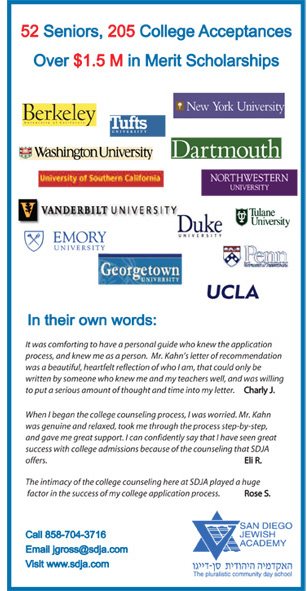 "The Child Who Is Held Captive--What does he say?" was the question asked in this additional seder portion. "Help me with Your great compassion. Bring us back and save us from our enemies. Hear our plea, for You listen to our prayers with sympathy. "The Child Who Is Held Captive--What does he say?" was the question asked in this additional seder portion. "Help me with Your great compassion. Bring us back and save us from our enemies. Hear our plea, for You listen to our prayers with sympathy.
"You must answer: I am my brother's keeper! I seek out my brother. For the sake of the missing and the captive I shall not be silent. For the sake of our sons I shall speak out 'To proclaim liberty to the captives and the opneing of the eyes of those that are bound.'"
In addition to the fifth-son reading, Goldwasser, Regev and Shalit were honored at other seders with such symbols as an MIA's chair, "an empty seat" to "remind us of our sons in captivity" and by an MIA's Cup, placed next to the cup reserved at the seder for the prophet Elijah.
The new symbolism reminded me of times when Passover seders were linked to other cries for freedom and justice. I can recall the first time we sang the Negro spiritual "Go Down Moses" during a seder to indicate our solidarity with the struggle of African-Americans for Civil Rights. I recall a "Matza of Freedom" added to our plate to underscore our common cause with Soviet Jews yearning for the right to freely emigrate to other countries.
I remember when an orange was added to many seder plates to symbolize the aspirations for recognition and inclusion in Jewish ritual by both women and gays. At other times, seders have been used to demonstrate our solidarity with Israel in its existential struggle, and with the people of Darfur province in the Sudan, facing genocide.
True, seders are a time when we remember the past--when we were slaves in Egypt, and strangers in a strange land. But they also are windows to our future as our society becomes ever more inclusive and caring.



PEOPLE OF THE BOOKS
Evangelicals: good or bad for Jews?
A Match Made in Heaven: America Jews, Christian Zionists, and One Man’s Exploration of the Weird and Wonderful Judeo-Evangelical Alliance by Zev Chafets, Harper, New York ISBN 978-0-06-089059-9, 2007, 231 pages, $13.95,
By Fred Reiss, Ed.D
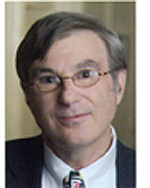 WINCHESTER, California—Zev Chafets, in his newest book, A Match Made in Heaven: America Jews, Christian Zionists, and One Man’s Exploration of the Weird and Wonderful Judeo-Evangelical Alliance, investigates how right-wing Christians act and interact with each other and with the Jewish community. He then asks if those deeds support or undermine the Jewish people in general and Israel in particular. WINCHESTER, California—Zev Chafets, in his newest book, A Match Made in Heaven: America Jews, Christian Zionists, and One Man’s Exploration of the Weird and Wonderful Judeo-Evangelical Alliance, investigates how right-wing Christians act and interact with each other and with the Jewish community. He then asks if those deeds support or undermine the Jewish people in general and Israel in particular.
His first encounter with fundamentalist thinking occurred in his youth, when a Christian friend informed him that as a member of the Chosen People, he would be going to hell when he died. This led Chafets on a life-long quest to understand fundamentalists. In so doing, he attended their churches and sat in revivalist tents. Chafets is now in a unique position to draw conclusions about Evangelical Christianity, Israel and American Jewry. He was born in Detroit and raised there until, as a late teenager during the Viet Nam War era, traveled to and remained in Israel; eventually becoming an Israeli citizen. He fought in the Israeli Defense Forces and in due course became the Director of the Government Press Office for former Israeli Prime Minister, Menachem Begin.
As a newly arrived émigré, Israeli territory had no emotional meaning to him. If the Arabs wanted land for peace, so be it. After a period in the Israeli Army, he went to work for the newly formed Likud Party. In 1977, the left-leaning Labor Party lost to the right-of-center Likud Party. This was the first time since the founding of Israel that the Labor Party lost a national election. Likud asserts the equivalent to America’s 19th century belief in Manifest Destiny by calling for the annexation of all the land that makes up Israel, including the West Bank, Golan Heights, Gaza Strip, and Jerusalem. While taking a hawkish stance against the Palestinians, they were the first party to negotiate peace with its neighbors. Menachem Begin signed the Camp David Accords, which returned the Sinai Peninsula to Egypt.
While working for Begin, Chafets learned that Christian Zionists, including Jerry Falwell and Pat Robertson, wanted to establish relations with the Israeli government. At that time, all Chafets could recall were his memories of the Bible-thumping hypocritical evangelical preachers from Detroit. Begin liked them from the start. The leadership of American Jewry was scandalized and outraged, but Begin didn’t care because they “were willing to go to mat for him against Jimmy Carter over the issue of Jewish settlements in the West Bank and Gaza.”
A Match Made in Heaven gives us the perspective of events and issues dear to American Jewry through the eyes of an Israeli Jew who once had American citizenship. For example, many American Jews saw the attack on the World Trade Center and the Pentagon as a discrete act of terrorism, like the bombing in Oklahoma City. They heard Jerry Falwell blame the attack on American immorality and others call for severing America’s close ties with Israel. Chafets supports Israeli belief that this assault on America is part of a worldwide jihad against Jews and Christians alike.
Chafets meets with two Evangelical Christians in the Israeli city Meggido, which some say is the site of the future Armageddon. They discuss eschatology, telling him that they subscribe to Hal Lindsey’s book, The Late Great Planet Earth. They believe that the Bible does make predictions; nations do fit into certain power patterns and most important of all, the Jews have returned to the Promised Land after two thousand years in exile. Who cares? No one, until Evangelical Christians became politically active. Now there is a great suspicion that “born again” George W. Bush is using his political position to push a biblical agenda.
 And yes, Evangelical Christians want to convert Jews, even if it’s by cell phone, as Chafets learned when he called a Baptist Church in Pontiac, Michigan. No wonder that American Jewry is leery of interactions with right-wing Christian groups. In 1923, the Moody Bible Institute of Chicago hired a converted Jewish professor to head their first chair in the Department of Jewish Studies. In 1964, the American Board of Missions to the Jews set up a booth at the New York World’s Fair. Less than twenty years later, the Southern Baptist Convention asked its members to divert all their energy and resources toward proclaiming the gospel to Jewish people. On one hand, Chafets asserts that Christian Zionists downplay their serious efforts to convert Jews, especially when dealing with Israel, while on the other he observes that moderates declare that except for extremists, evangelical Christians do not intend to turn America into a theocracy. And yes, Evangelical Christians want to convert Jews, even if it’s by cell phone, as Chafets learned when he called a Baptist Church in Pontiac, Michigan. No wonder that American Jewry is leery of interactions with right-wing Christian groups. In 1923, the Moody Bible Institute of Chicago hired a converted Jewish professor to head their first chair in the Department of Jewish Studies. In 1964, the American Board of Missions to the Jews set up a booth at the New York World’s Fair. Less than twenty years later, the Southern Baptist Convention asked its members to divert all their energy and resources toward proclaiming the gospel to Jewish people. On one hand, Chafets asserts that Christian Zionists downplay their serious efforts to convert Jews, especially when dealing with Israel, while on the other he observes that moderates declare that except for extremists, evangelical Christians do not intend to turn America into a theocracy.
Throughout the book, Chafets is asking, is the support of Evangelical Christianity good for the Jews, or not? By way of interesting vignettes and anecdotes Chafets takes us into the world of Christian Zionists and their interaction among themselves and with world leaders. Falwell tells Chafets that “critics of my ministry have tried to drive a wedge between me and the Jewish community… They forgot that my master was a Jewish rabbi.” Israeli Prime Minister Menachem Begin had no problem with either Falwell or with the Moral Majority’s four points of pro-life, pro-traditional family, pro-American, and support for the State of Israel.
So, are Israeli Jews from Mars and American Jews from Venus? Perhaps this was the case until 9/11, asserts Chafets, when American Jewish liberals realized that the Arabic translation of Mein Kampf was a best seller in the Middle East, the Palestinian rejection of the Camp David two-state solution implied more than territory was at stake, and Islamic heads-of-state began declaring, in support of article 22 in the Hamas Charter, that Jews controlled the world through a Zionist conspiracy. It was no longer Israel, but the Jews who were the enemy. Israelis support America’s attack on Iraq and the removal of Saddam Hussein. “By toppling him, the United States was sending a clear message: even if we think you’d do something like 9/11, you’re gone.”
Throughout A Match Made in Heaven, the reader is made aware of the author’s view that evangelicals are basically good people who support Israel because that’s what the Lord wants. Consequently, they support American presidents who show unconditional support of Israel. Chafets sends the clear message that Israel gives unconditional support for Christian Zionists and hopes that American Jewry will see beyond the Christian mission to convert non-believers and subsequently rally behind presidents who support a strong Middle Eastern policy that recognizes the legitimacy and survival of a Jewish state.


ADVENTURES IN SAN DIEGO JEWISH HISTORY
Editor's Note: We are reprinting a series of articles that the Southwestern Jewish Press ran in July 1949 providing the history and purpose of numerous Jewish organizations in San Diego. If you have historical topics about the San Diego Jewish community you would like us to explore, please e-mail your suggestions to editor Don Harrison at sdheritage@cox.net
Jewish War Veterans Post 185
From the Southwestern Jewish Press, July 1949, pages 1, 8
With the election of Manuel S. Fisher to Post Commander, Harry Aronoff to Senior-Vice Commander, Sam Klug to Junior Vice Commander, Rabbi Morton J. Cohn as Chaplain, Ralph Feldman as Judge Advocate, Allan Lame as Quartermaster, David Brooks as Adjutant and David Frank as Officer of the Day, the Jewish War Veterans Post 185 began an active year.
Under the guiding hand of Harry Aronoff, that hard-working team of Aronoff, Joe Shifrenson and Joe Spatz planned and completed several fund raising affairs. The next affair a Card Party at Temple Center at 8 p.m. on July 10th is the next Post venture.
On Sunday, February 20th the Post took its place with other patriotic organizations at the U.S. Naval Hospital Chapel by dedicating the Jewish War Veterans’ Window. Top ranking Naval officers took part in the ceremony.
Further participation in community and service functions were exemplified by participation in “I Am An American Day” and the taking of an active part in the Joint Memorial Service at Fort Rosecrans on Memorial Day. Services that same day were also conducted by Chaplain Cohn and Commander Fisher at Home of Peace Cemetery. Day to day cooperation with other veteran organizations is maintained through active participation in the Veterans Couny Council.
There is a real need for every Jewish veteran to join JWV Post 185. JWV is not merely an association of ex-servicemen concerned with their own welfare, it exists as an instrument of service to all Jewry since it represents Jewry’s patriotic devotion to American and living evidence of the manpower and sacrifice Jews have contributed to keep America secure and free. JWV throughout the country has helped the cause of Israel by shipments of over 100,000 U.S. Army uniforms and other equipage, by meetings with non-Jewish leaders of veterans’ groups to reject the hate-sheet allegations that American Jews, in supporting Israel, were manifesting dual loyalties.
JWV speaks directly to the vast multitude of American veterans through the other veterans’ organizations with which it maintains cordial, working relationships. Through their leaders and individual members, it was able to interpret for veterans of all faiths such vital Jewish problems as Israel’s struggle for Independence. In cognizance of the voice of the Jewish veteran as magnified by the collective opinion of other ex-servicemen’s organizations, the JWV found it essential to all Jewry to establish a National Legislative Bureau in Washington. This Bureau devotes itself to legislative matters of concern to the general Jewish community, as well as to problems affecting veterans.
President Harry S. Truman has said of the Jewish War Veterans “As a symbol of patriotic service rendered by our citizens of Jewish faith, your organization is the living answer to those who would confuse our people with the evil doctrines of bigotry and hatred.”
The Jewish War Veterans are doing a job!
Junior Charity League
From Southwestern Jewish Press, July 1949, pages 1, 8
The Junior Charity League, which now has a membership of 20, was organized in 1916 by a group of young women as a social club. Several years later, as the city grew and needy cases came to the attention of the members, the club was reorganized to embrace charity.
During and for many years after World War I, the Junior Charity League financially aided many Jewish emigrees who were stranded in Tijuana. They also contributed to the P.T.A. toward hot lunches for school children. Before the Jewish Welfare Society came into being, the J.C.L. subsidized poor families and since then have assisted the society whenever called upon.
During the past year, the League helped substantially in furnishing an apartment now being used to house incoming refugees; contributed $50.00 toward a Brandeis Scholarship; donated to the Forrest Warren Fund, the Braille Club and 11 worthy civic funds. Members knitted sweaters, caps, booties and made nighties and kimonos for babies abroad—the first package having been personally delivered to Camp Atlit in Israel by Mrs. Moorsteen last month. Members are completing a second shipment to be sent abroad soon.
Officers are Ray Solomon, president; Helen Fishman, vice president; Esther Moorsteen, secretary and Beebe Goldhammer, treasurer.
Beth Jacob Auxiliary
By Anne Shelley, president
From Southwestern Jewish Press, July 1949, pages 1, 8:
One hundred women form the Auxiliary of the Beth Jacob Congregation. As the name implies the auxiliary’s purpose is to aid in the affairs of the Beth Jacob Congregation and to cooperate with the mens (sic) group in the social and philanthropic work of Beth Jacob as well as the promotion of religious activities.
The Beth Jacob Auxiliary has taken part in all communal affairs and provided workers for all appeals and drives.
The main goal of the auxiliary for the coming year is to see that the Beth Jacob Congregation will have as its own a new, bigger and finer building next year.

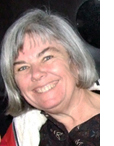
 Nancy Harrison Nancy Harrison
cruise & tour specialist
(619) 265-0808
Not only better prices, but excellent, caring service!

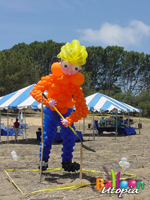 |
Balloon Utopia
Sandi Masori
619 339 8024
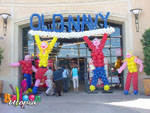 |
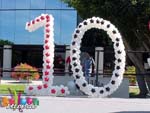
! |
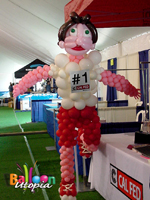 |

SAN DIEGO JEWISH WORLD THE WEEK IN REVIEW
Carol Davis in La Jolla, California: 33 Variations probes Beethoven's obsession
Ulla Hadar in Kibbutz Ruhama, Israel: Battle to bring, keep water in the Negev
Donald H. Harrison in Jamul, California: On the land-use warpath in rural Jamul
Rabbi Baruch Lederman in San Diego: Rav Henoch Leibowitz dies at 92 in Queens
Dov Burt Levy in Peabody, Massachusetts: A miraculous report from Sderot
Rabbi Leonard Rosenthal in San Diego: Do free people have to attend a seder?
Adventures in San Diego History: The Southwestern Jewish Press in July 1949 printed articles detailing the histories and purposes of various Jewish organizations in San Diego. Today we reprint the stories about Hadassah and the Junior Section of Senior Hadassah.
Carol Davis in San Diego: Speaking of Pharaoh's Egypt: Aida is back
Eran Lerman in Jerusalem: Israel has domestic political chametz which
it would be well to sweep out before Pesach
Rabbi Dow Marmur in Jerusalem: In Israel, water is an issue that is of both technological and theological concern
Sheila Orysiek in San Diego: Chapter Four in the serialization of her novel, Reluctant Martyr
William Propp in La Jolla: David Noel Freedman: an appreciation
Adventures in San Diego History:We begin a series of stories from the 1949 Southwestern Jewish Press in which each Jewish organization was asked to tell its history and activities.
Carol Davis in Coronado, California: If your family made its fortune by theft, would you willingly return the money?
Dow Marmur in Jerusalem: Jimmy Carter's unwelcome benevolence
Ira Sharkansky in Jerusalem: Notes from ever-changing Haggadot
Adventures in San Diego History: San Diego's Jewish community focused in 1949 on the resettlement of refugees in Israel and on aid to needy Jews in San Diego and abroad
Shoshana Bryen in Washington, D.C.: Welcome back, welcome back Berlusconi
Larry Gorfine in San Diego:Jews play prominent roles in S.D. politics
Gary Rotto in Angelus Oaks, California: Debating a professional at a 'big boy' retreat for Jewish leaders at Camp Mountain Chai
Adventures in San Diego History: In 1947, the Jewish community in San Diego was alive with fresh beginnings: A new softball leage, a CARE office, groundbreaking in North Park for Tifereth Israel; a new sefer Torah in Tijuana, and the installation of a Hillel unit at San Diego State
Judy Lash Balint in Jerusalem: 20 ways you know it's Pesach in Jerusalem
Shoshana Bryen in Washington, D.C.: Iran becomes increasingly frustrated in Iraq
Donald H. Harrison in La Jolla, California: Congregation Beth Israel's exhibit shows Israel that American visitors photograph
Rabbi Dow Marmur in Jerusalem: Christian Peacemaker Teams (CPT) provide necessary peace presence in Hebron
Adventures in San Diego History: In 1947 the community was focused on helping survivors of the Holocaust and on establishing such new institutions as Hillel at San Diego State University and a Jewish summer camp.
< BACK TO TOP
|
|

 —
—